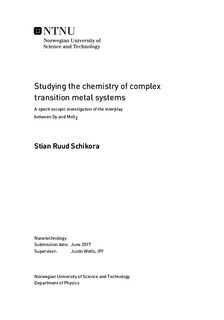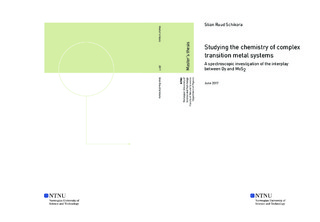| dc.description.abstract | In this thesis, the interactions between MoS2 and dysprosium have been investigated by spectroscopic and diffractive techniques. As the experimental research on dysprosium compounds is scarce, the possible applications of these could be many. Depending on the stoichiometry of the compound, it may contribute in fields such as spintronics, magneto-optics or as a semiconducting material.
Preliminary studies to introduce dysprosium as a magnetic dopant in the van der Waals gaps of the molybdenum disulphide bilayer structure revealed an interesting chemical reaction between the two compounds. As this was worth further investigation, the interplay between MoS2 and the f-block element, dysprosium, has been investigated in situ by the means of X-ray photoelectron spectroscopy (XPS), low energy electron diffraction (LEED) and angle resolved photoemission spectroscopy (ARPES).
Results indicate the formation of dysprosium sulphide thin films by sulphur extraction from the MoS2 when annealing the samples to 300°C. For sufficiently thin samples in the range of 2-3 monolayers this reaction is observed to occur even at room temperature, and further propagated by heating. Using a finite element model, the layered stoichiometry of the dysprosium sulphide was extracted. In combination with the observed diffraction patterns from LEED, this supports the formation of a possible mono- or disulphide, differing from the most stable bulk formation of Dy2S3. Studying the electronic structure by ARPES showed a decrease of the valence band maximum of MoS2 at the M -point by 130 meV.
Oxidation experiments of the deposited dysprosium overlayer displayed different attributes dependent on whether the film had been heated before oxygen exposure or not. A film that had mildly reacted with the MoS2 substrate showed characteristics similar to that of the sesquioxide with insulating properties, but could also be other possible oxidation states. If the overlayer was annealed to 300°C prior to oxygen exposure reactions suggesting the formation of a dysprosium oxide sulphide was observed.
The results from this work should provide a good foundation for further studies of the synthesis of dysprosium oxide and sulphide thin films. Additionally, the calculated value of the spin splitting of the Dy5p-orbital of 5.67 ± 0.1eV should be useful as reference for further spectroscopic studies of this material. | |

